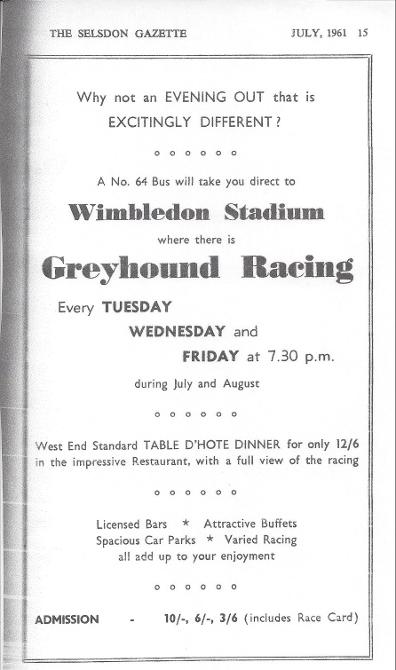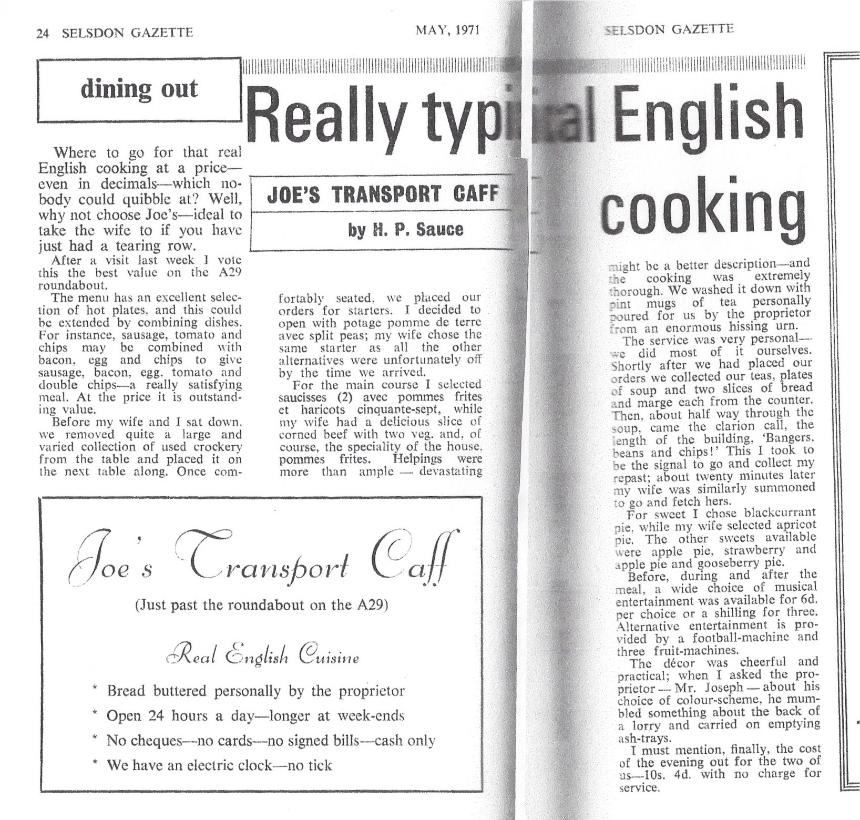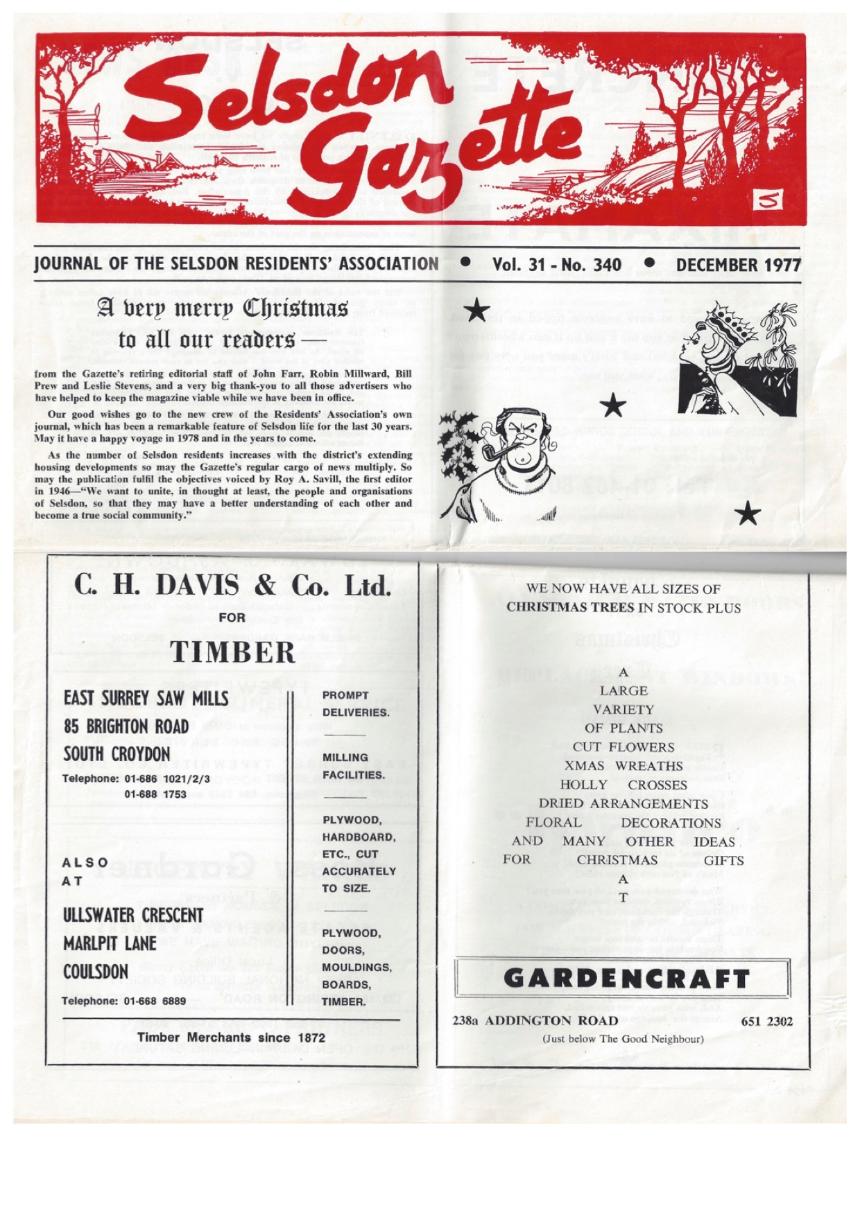The Early Days of the Selsdon Gazette
(first published in the Gazette of December 2016 as 'Glimpses of Old Selsdon XXV')
In August 1946, the Selsdon Residents' Association committee discussed a report on restarting the Selsdon Gazette but this time under the auspices of the association. Two estimates had been obtained, from The Lincolnshire Chronicle and the local Heath Press in Croydon. The former was cheaper for a four-page leaflet, but the latter even more competitive for a 12 page monthly for 2,200 copies (there were then 2,086 houses in Selsdon). At a later meeting advertisement charges were agreed to meet the cost of printing and Roy Savill, a reporter with a local paper, undertook be the joint editor with another lady yet to be appointed - later revealed as Mrs Louise Bartlett. The actual date of publication is not known but the first new Selsdon Gazette appeared in December 1946. And 70 years later and now at number 777 it is still distributed to every household in Selsdon. It may not look as professional as the magazine of a certain neighbourhood, but it does appear monthly, or to be precise, eleven times a year!
Before the war, a firm of printers in Ashford, Middlesex, Manor Press, published a blue covered Selsdon Gazette, which was one of several similar magazines for different parts of Croydon. It ceased publication on the outbreak of war and most copies ended up as wartime salvage. I have a pristine copy of No. 48 for January 1935 before me. It has 24 pages of which 10 were contributed by the SRA and other Selsdon organisations such as the churches. The rest of the pages comprised advertisements, some for Selsdon traders, but also for Batchelars of North End, Grants and the Davis Theatre.
In the first issue of the new Gazette was the following letter, which reminds us that some of the problems of today were also problems then:
Ted Frith
Thanks also to Ted for supplying all of the other extracts from the Gazette on the rest of this page.
Helping Hand
from The Selsdon Gazette Vol 11 No 10 - September, 1947
(republished as BLAST FROM THE PAST - in the Gazette of May 2017)
This piece, although it is not specific to Selsdon, is a fascinating bit of post WWII history.
“Girl Friday” of “The Croydon Times” included in her column the following information, which may probably interest some of our readers:-
Harassed housewives and work-weary husbands, neither of who feel like turning a hand to the garden in the evenings, might find this tip useful. I understand that for the nominal “payment” of a meal and a few cigarettes you can enrol a couple of German prisoners of war to do your gardening in the evenings. Method of obtaining the services of these men is to go to the nearest P.O.W. camp, I understand, and make arrangements with the officer in charge. If you do manage to obtain one or two men to do your garden, don’t forget that the only “payment” must be in the form of a meal and cigarettes. Money must not – repeat not – be given or else you will find yourself in the dock of the nearest police court.

|
Really Typical English Cooking.pdf Size : 398.207 Kb Type : pdf |


Selsdon Gazette October 1970 - Editorial
by Keith Potter who was Editor at the time
(republished in the Gazette of June 2017)
It would, I think be useful at this stage to set down the way in which the “Selsdon Gazette” is produced – together with some background information – so that any misunderstanding can be avoided. We receive a number of complaints which would probably not have been made had the complainants know our system of working.
First of all, the magazine is published by the Residents’ Association as a service to the residents of Selsdon. Originally it was mainly a vehicle for Residents’ Association news and views - now it carries a great deal else of general interest and reports from a wide range of local organisations. The editorial policy is not dictated by the Residents’ Association and views expressed in the Editorial articles are those of the Editor or author and not necessarily those of the Residents’ Association. The column “What Matters to Us” carries specifically Residents’ Association news and opinions.
It would, I think be useful at this stage to set down the way in which the “Selsdon Gazette” is produced – together with some background information – so that any misunderstanding can be avoided. We receive a number of complaints which would probably not have been made had the complainants know our system of working.
The magazine has no special religious or political bias – we shall praise or criticise when we feel we should, but in the long run hope that we shall be seen to have been fair to all viewpoints. So far as the inclusion or otherwise of letters or articles is concerned, we publish what is contributed, provided that there is space. It is very rarely that anything has to be left out because it is unfit to publish – which says a great deal for the common sense of our contributors.
Financially the magazine exists entirely on its advertising revenue. The shilling Residents’ Association subscriptions are to finance the Residents’ Association: The Gazette goes to everyone RA member or not. At the present moment, the advertising revenue is not enough to cover printing costs – the only real answer to this is for us to attract more advertising which is, unfortunately, not easy.
The actual magazine is the result of the work of all the contributors, a Gazette staff of five, all voluntary and unpaid, a very helpful firm of printers and a small army of volunteer distributors.
Contributions are sent to the Editor, usually in the week before the closing date, and his first job is to collect all the material, either type out or consign to the waste-paper basket any which is illegible, tidy it up and generally prepare the ‘copy’ for the type setters. The most welcome articles are typewritten, double-spaced and on one side of the paper only, and which the authors have read through and corrected, as these can go straight forward to the printers without any editing being needed. The Editor, or Mrs Thomas, the Assistant Editor, also writes and includes an Editorial. Terminus Tattle appears out of the mystery box and the originals of cartoons, drawings and photographs are assembled. A day or two after the “closing- date”, all this copy goes off to the Heath Press.
At the same time, over in Foxearth Road, Mrs Carmichael, our Advertising Manager, gathers up advertising copy which she has received during the month and sends it to the printer, at the same time making a complete list of all the advertisements which are to be included in the new issue. Copies of this list go to the printer and to the Editor.
Within about a week, “galley-proofs” are received back from the printers – that is, all the material is printed in long columns four inches wide and fourteen inches long, with all the different articles run on one after the other. The Editor “proof-reads” these to see if there are any mistakes, then gets a last month’s Gazette, a pair of scissors and a pot of paste and begins to make a “mock-up’ of the new magazine. The corrected galley proofs are cut up and then stuck into the previous “Gazette” so that the printer may know how we want the material and advertisements arranged. It is at this stage that either everything fits beautifully or else the wretched thing will not work out at all. There are a number of tricks which can be employed to make everything fit – examples are leaving out the “Directory” to create more space or putting in a dummy advertisement to fill in an awkward gap. The magazine is printed eight pages at a time, which means that it is more difficult for the printer – and wasteful – if the size of the magazine is not a multiple of eight pages. If the material just will not fit it is sometimes necessary to leave and article out or to fit an advertisement in where it does not really show up to the best advantage - we are sorry that this sort of thing has to happen sometimes, but the “Gazette” is not infinitely flexible and there is a limit to the squeezing-in and filling-out that we can do.
It is sometimes possible at the make-up stage to fit extra material in – but contributors whose material arrives after the closing date and has to be “set-in” in this way will realise that there is no guarantee that there will be room. In the last few months there usually has been but that may well not continue especially if we have to cut the size of the magazine down to save money later on.
Anyway, the makeup goes back to the printer and, after a few days, “page-proofs” come back. These are large sheets with eight pages of Gazette printed on them, which just have to be checked to make sure that everything is in the right place. Inserting new material or making major alterations at this stage involves the printer in a great deal of extra work – which apart from the cost would mean delaying the magazine.
The last stage is to send the page-proofs back so that the actual magazines may be printed. These are sent by the Heath Press direct to Mr Millward, our Distribution Manager, who shares with Mrs Millward the unenviable task of unpacking and bundling into small units about 2,700 magazines. They then take these to the individual distributors who deliver them house-to-house, come rain or shine.
The final link in Gazette-staff team is our Treasurer, Mr Cumner, who receives the bill from the printers and pays it, and also sends out bills to the individual advertisers. In addition he keeps the rest of the Management supplied with stationery, and also makes warning noises in the direction of the Editor if the size of the magazine is getting too large in relation to the volume of advertising it is carrying.
So now you all know – it has taken rather a long time to explain because it is really quite a long and involved process producing each issue of the ’Gazette’ Fortunately, the work is not too onerous for the voluntary Management-team because people as a rule are helpful and considerate. Provided the team is complete things run pretty smoothly. Probably the greatest need for practical help at the moment is on the distribution-side – some people to come forward and plug the gaps in our house-to-house distribution network and, before very long, someone to take on half of Mr. Millard’s work, which, as Selsdon grows, is just going to be too much for one person. It would be nice, too, to have some more help on the editorial-side – particularly someone (or two or three someones) willing to go along to meetings of local organisations and represent the ‘Gazette’ or act as reporters. Now that the ‘Gazette’ has an Editor who is working full time during the day, this is a part of the service which has rather slipped. If people will come forward to do this, they could at the same time gather in tit-bits of Terminus Tattle to be fed into the Tattle-machine which is hiding down in the basement somewhere.
Don’t be shy!
Current Editor’s Comments: While the first 5 paragraphs still apply the process of production is very different today. All editorial copy and adverts are now supplied electronically so there is no literal ‘cut-and-paste’. There is no galley proof stage requiring hand cut mock-ups. Electronic page proofs are sent from the printers and just require checking although there is still scope for a little juggling to make sure that the pages are all filled and the overall length fits the page format. Distribution, however, is exactly as it was almost 50 years ago!

|
To Be or Not To Be.pdf Size : 537.43 Kb Type : pdf |


|
Gazette 60 years.pdf Size : 3519.764 Kb Type : pdf |